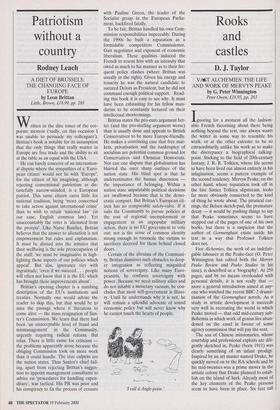Rooks and castles
D. J. Taylor
VACT ALCHEMIES: THE LIFE AND WORK OF MERVYN PEAKE by G. Peter Winnington Peter Owen, £18.95, pp. 263 Ignoring for a moment all the fashion- able French theorising about there being nothing beyond the text, one always wants the writer in some way to resemble his work, or at the other extreme to be so extraordinarily unlike his work as to make the discrepancy a biographical talking- point. Sticking to the field of 20th-century fantasy, J. R. R. Tolkien, whose life seems to have been lived out almost entirely in his imagination, seems a pattern example of the second tendency. Mervyn Peake, on the other hand, whose reputation took off in the late Sixties Tolkien slipstream, looks far more obviously connected to the kind of thing he wrote about. The piratical ear- rings, the Belsen sketch-pad, the premature decay — it would be pushing things to say that Peake sometimes seems to have stepped out of the pages of one of his own books, but there is a suspicion that the author of Gonnenghast exists inside his text in a way that Professor Tolkien does not.
Vast Alchemies, the work of an indefati- gable labourer at the Peake-face (G. Peter Winnington has edited both the Mervyn Peake Review and Peake Studies in his time), is described as a 'biography'. At 250 pages, and by no means overloaded with personal details, it is not really that — more a general introduction aimed at any- one who watched the recent BBC 2 drama- tisation of the Gorrnenghast novels. As a study in artistic development it succeeds very well in recreating the world in which Peake moved — that odd mid-century sub- Bohemia in which work of genius lies aban- doned on the easel in favour of some agency commission that will pay the rent.
The son of Chinese missionaries, whose courtship and professional exploits are dili- gently sketched in, Peake (born 1911) was clearly something of an infant prodigy. Inspired by an art master named Drake, he quickly moved on to the RA schools and by his mid-twenties was a prime mover in the artistic colony that Drake planned to estab- lish on the island of Sark. Already most of the key elements of the Peake persona seem to have been in place. Six feet tall and flamboyantly dressed, he was quite capable of thumping island bar-proppers who fancied him effeminate. Outlook, technique, the whole approach to the can- vas was, as. Winnington shows, inflamed by a chronic restlessness. Married to a young student called Maeve Gilmore — a nicely brought up girl who was driven to their first date by her mother's chauffeur he produced hundreds of sketches of his wife's face, often at the rate of one a minute.
As for the published work, now emerging in a series of illustrated books for Chatto & Windus, the Peake line — macabre, angu- lar, full of cross-hatchings and broken lines — goes back as far as Bewick. The distur- bance at its centre, and at the centre of the mind behind it, seems thoroughly modern, though: Peake's time as a war artist, culmi- nating in a stay at Belsen shortly after its liberation, undoubtedly gave something to the Gormenghast trilogy (Titus Groan, Gor- menghast and Titus Alone), sympathetically steered into print by Graham Greene and published between 1946 and 1959. At the same time even the reviewers of his first children's book, Captain Slaughterboard Drops Anchor (1939), had worried about its likely effect on the average infant sensibility.
By the time of Titus Alone, Peake's career was effectively over. An early victim of Parkinson's, he was diagnosed as suffer- ing from 'premature senility' at the age of 47. The last decade of his life was a night- mare of electrodes and brain operations. An older friend who came to visit him shortly before his death was mistaken for his son by a hospital attendant. All this is neatly conveyed, with occasional minor lapses of detail (Sir John Squire's log-rolling London Mercury, in which Peake published early drawings, hardly counts as a 'major literary periodical of the Thirties') even if it rarely touches on the most obvious life/art connection. There is an odd coldness at the heart of Gormeng- hast, a sense of the absolute minimum being done to entice the reader in. As a child I remember being awed but also faintly repelled by Titus Alone, the feeling of a stony interior never quite pushed aside by the dazzling imaginative structures on display. Like the artist himself it is a work of daunting self-sufficiency — rapt, absorbed and, at any rate spiritually, with- out heirs.



































































 Previous page
Previous page